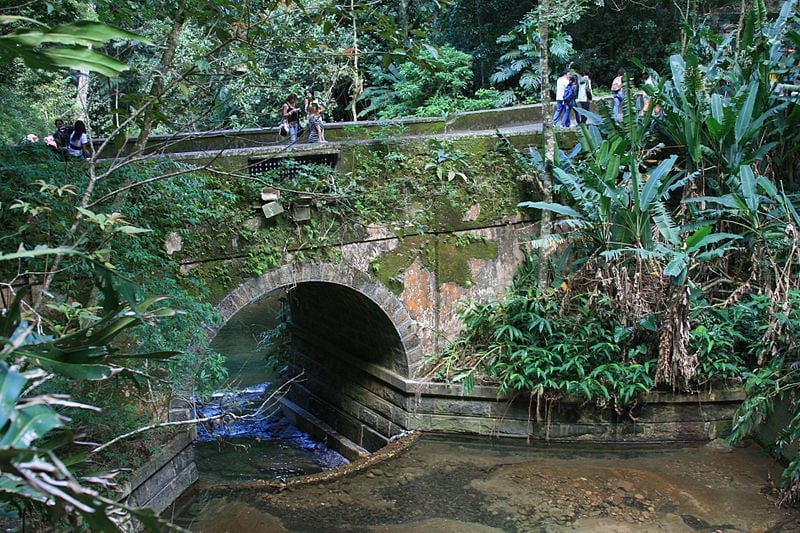The National Park of Rio de Janeiro or the Tijuca Forest became the Tijuca National Park, on February 8, 1967. It is a part of the Atlantic Forest biome. Till the mid-17th century, the forest was pristine. Then, it was discovered by the Indians, who stayed at the shore of the ocean and survived by hunting, fishing, and planting cassava.
Various viewpoints in the park are Vista Chinese, View of the Admiral, Mirante Dona Marta, and Painswick. You would be able to enjoy the bird’s eye views of the Parrot Peak, Tijuca Peak, Pedra Bonita, and Pedra da Gávea. Besides hiking in the forest, you may also enjoy waterfall baths, and picnicking in the calm and clean environment of the rainforest. You may also tour the forest via a helicopter flight.
Hiking Trails at Tijuca Forest
- Pedra da Gávea trail: The journey time is 3 hours. The point of arrival is Road Sorimã – Barra da Tijuca. This trail takes you on a tour of the magnificent Gavea mountain.
- Parque Lage to Corcovado Trail: The journey time is 2 hours and 30 minutes. This heavy difficulty trail lets the visitors have a fantastic time at the outdoor showers, gazebos, and climbing routes. At the end of this trail, you can extend your journey to the Christ the Redeemer Monument. Buy the tickets online (in advance).
- Pico da Tijuca: The journey time is just one hour. The point of arrival is Bom Retiro. You may also climb this peak, if you want an added adventure.
- The trail of Internal Circular Castro Maya: The journey time is 2 days, covered separately. The point of arrival is Forest Sector Tijuca point. The trail covers the Playground of Mayrink, and Silvestre chapels. It is more like a historical journey. Various places covered in the trail include the old residence of the Barão d’Escragnolle (today it has been turned into Esquilos restaurant), 120 archeological sites, Residence of Visconde do Bom RFT Ero, Old slavery houses of Major Archer, and the Christ the Redeemer Statue.
The forest boasts of a rich flora and fauna. Some of the animals that you may encounter during the trails are capuchin monkeys, anteaters-Mirim, lizards and geckos, caxinguelês, snakes, raccoons, etc. You may also hear the sweet calls of the juritis hummingbirds.
The park offers several services to the visitors, including 4 restaurants, 3 snack shops, and 4 souvenir shops. There are 15 areas for picnicking, and a heliport. The forest also houses a train station for train to the Christ the Redeemer Statue. Some of the popular places that are a part of this majestic forest are the Chapel Mayrink, the Sugar Loaf, Pedra da Gávea, and the Chinese view.
Tips
- Hiking in some protected areas has some risks, such as biting animals, or falls. It is recommended to stay on the track routes.
- Wear comfortable shoes for hiking. Say no to flip flops.
- Apply sunscreen before embarking upon the trail.
- If there is an indication that it may rain, postpone your hiking trip as the trails can be dangerous.
- Leave for the hiking trail during early morning, so that you are back on time, as it gets dark after the sunset.
Tijuca Forest Map
Tijuca Forest Facts
- Initially, the park covered an area of 33 km sq. It was expanded to 39.51 km sq in 1967.
- About 25 endangered species of animals are protected in the forest.
- There are around 1619 plant species in the park and out of these about 433 are endangered.
- There are about 37 amphibian species, 33 reptile species, 189 bird species, and 72 mammal species in the forest.
Where is Tijuca Forest?
Located in Rio de Janeiro city, the Tijuca Forest can be accessed via different modes of transportation, including car, bike, motorbike, bus, and train. You may also choose to tread the park on foot. The nearest airport to the forest is Rio de Janeiro/Galeão – Antônio Carlos Jobim International Airport. You may also take a taxi to reach the park.
Best time to visit Tijuca Forest
Weekends and school holidays are the high season days. If you wish to escape the crowds, then you may choose to visit the park during weekdays. The months of December to March are warmer, and thus ideal for visiting Brazil.The months to avoid are May through September.
Tijuca Forest Hours
The opening hours for the Tijuca Forest Sector are from 8:00 a.m. to 5:00 p.m. (6:00 p.m. in summers). The administration opens from Mondays to Fridays from 9:00 a.m. to 6:00 p.m.
Tijuca Forest Tickets
Only a visit to the Corcovado mountain is charged. For the individuals who are driving or walking into the park on their own, (Brazilian Real) R$ 31.36 is charged during the high season, weekends and holidays, and R$ 21.36 is charged during the low season. No fee is charged for admission of children under 12 years of age. You can park your cars or motorcycles in the parking. From the parking area, vans take the visitors to the Christ the Redeemer statue.
Those who prefer to travel via train, need to check the tremdocorcovado.com.br website for fees, as different fee is charged for different boarding points. The train can be boarded from Cosme Velho, Van – Largo do Machado, Painswick, and Corcovado.
More on Tijuca Forest
What are the coordinates of the Tijuca Forest?
22.9630° S, 43.2450° W
Who is responsible for the safety of the visitors?
The Chico Mendes Institute for Biodiversity Conservation – ICMBio, helps in maintaining the safety of the visitors at the forest.
How many people visit the forest?
Over 1.5 million people visit the forest annually.
Related : Tijuca Forest Infographic |
Image Credit : Halley Pacheco de Oliveira
AS20150919

